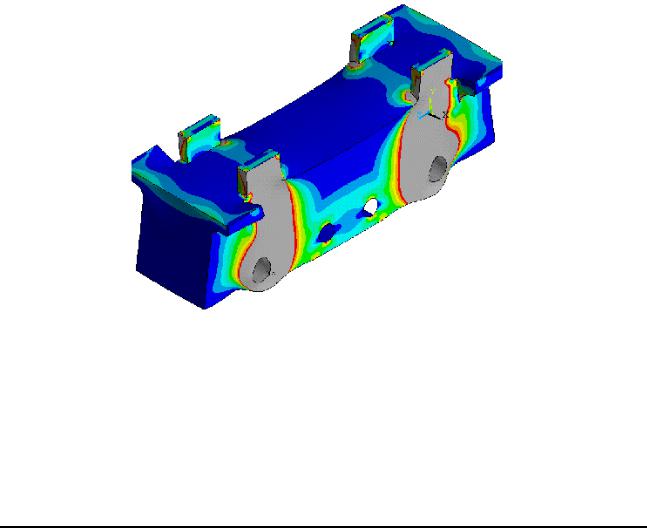
- •Copyright Notice
- •Table of Contents
- •Chapter 1. Introduction
- •I. Basic Concepts
- •Examples:
- •Why Finite Element Method?
- •Applications of FEM in Engineering
- •Examples:
- •A Brief History of the FEM
- •FEM in Structural Analysis (The Procedure)
- •Example:
- •Available Commercial FEM Software Packages
- •Objectives of This FEM Course
- •II. Review of Matrix Algebra
- •Linear System of Algebraic Equations
- •Matrix Addition and Subtraction
- •Scalar Multiplication
- •Matrix Multiplication
- •Transpose of a Matrix
- •Symmetric Matrix
- •Unit (Identity) Matrix
- •Determinant of a Matrix
- •Singular Matrix
- •Matrix Inversion
- •Examples:
- •Solution Techniques for Linear Systems of Equations
- •Positive Definite Matrix
- •Differentiation and Integration of a Matrix
- •Types of Finite Elements
- •III. Spring Element
- •One Spring Element
- •Spring System
- •Checking the Results
- •Notes About the Spring Elements
- •Example 1.1
- •Chapter 2. Bar and Beam Elements
- •I. Linear Static Analysis
- •II. Bar Element
- •Stiffness Matrix --- Direct Method
- •Stiffness Matrix --- A Formal Approach
- •Example 2.1
- •Example 2.2
- •Distributed Load
- •Bar Elements in 2-D and 3-D Space
- •2-D Case
- •Transformation
- •Stiffness Matrix in the 2-D Space
- •Element Stress
- •Example 2.3
- •Example 2.4 (Multipoint Constraint)
- •3-D Case
- •III. Beam Element
- •Simple Plane Beam Element
- •Direct Method
- •Formal Approach
- •3-D Beam Element
- •Example 2.5
- •Equivalent Nodal Loads of Distributed Transverse Load
- •Example 2.6
- •Example 2.7
- •FE Analysis of Frame Structures
- •Example 2.8
- •Chapter 3. Two-Dimensional Problems
- •I. Review of the Basic Theory
- •Plane (2-D) Problems
- •Stress-Strain-Temperature (Constitutive) Relations
- •Strain and Displacement Relations
- •Equilibrium Equations
- •Exact Elasticity Solution
- •Example 3.1
- •II. Finite Elements for 2-D Problems
- •A General Formula for the Stiffness Matrix
- •Constant Strain Triangle (CST or T3)
- •Linear Strain Triangle (LST or T6)
- •Linear Quadrilateral Element (Q4)
- •Quadratic Quadrilateral Element (Q8)
- •Example 3.2
- •Transformation of Loads
- •Stress Calculation
- •I. Symmetry
- •Types of Symmetry:
- •Examples:
- •Applications of the symmetry properties:
- •Examples:
- •Cautions:
- •II. Substructures (Superelements)
- •Physical Meaning:
- •Mathematical Meaning:
- •Advantages of Using Substructures/Superelements:
- •Disadvantages:
- •III. Equation Solving
- •Direct Methods (Gauss Elimination):
- •Iterative Methods:
- •Gauss Elimination - Example:
- •Iterative Method - Example:
- •IV. Nature of Finite Element Solutions
- •Stiffening Effect:
- •V. Numerical Error
- •VI. Convergence of FE Solutions
- •Type of Refinements:
- •Examples:
- •VII. Adaptivity (h-, p-, and hp-Methods)
- •Error Indicators:
- •Examples:
- •Chapter 5. Plate and Shell Elements
- •Applications:
- •Forces and Moments Acting on the Plate:
- •Stresses:
- •Relations Between Forces and Stresses
- •Thin Plate Theory ( Kirchhoff Plate Theory)
- •Examples:
- •Under uniform load q
- •Thick Plate Theory (Mindlin Plate Theory)
- •II. Plate Elements
- •Kirchhoff Plate Elements:
- •Mindlin Plate Elements:
- •Discrete Kirchhoff Element:
- •Test Problem:
- •Mesh
- •III. Shells and Shell Elements
- •Example: A Cylindrical Container.
- •Shell Theory:
- •Shell Elements:
- •Curved shell elements:
- •Test Cases:
- •Chapter 6. Solid Elements for 3-D Problems
- •I. 3-D Elasticity Theory
- •Stress State:
- •Strains:
- •Stress-strain relation:
- •Displacement:
- •Strain-Displacement Relation:
- •Equilibrium Equations:
- •Stress Analysis:
- •II. Finite Element Formulation
- •Displacement Field:
- •Stiffness Matrix:
- •III. Typical 3-D Solid Elements
- •Tetrahedron:
- •Hexahedron (brick):
- •Penta:
- •Element Formulation:
- •Solids of Revolution (Axisymmetric Solids)
- •Axisymmetric Elements
- •Applications
- •Chapter 7. Structural Vibration and Dynamics
- •I. Basic Equations
- •A. Single DOF System
- •B. Multiple DOF System
- •Example
- •II. Free Vibration
- •III. Damping
- •IV. Modal Equations
- •V. Frequency Response Analysis
- •VI. Transient Response Analysis
- •B. Modal Method
- •Cautions in Dynamic Analysis
- •Examples
- •Chapter 8. Thermal Analysis
- •Further Reading

Lecture Notes: Introduction to Finite Element Method |
Chapter 1. Introduction |
Computer Implementations
•Preprocessing (build FE model, loads and constraints)
•FEA solver (assemble and solve the system of equations)
•Postprocessing (sort and display the results)
Available Commercial FEM Software Packages
•ANSYS (General purpose, PC and workstations)
•SDRC/I-DEAS (Complete CAD/CAM/CAE package)
•NASTRAN (General purpose FEA on mainframes)
•ABAQUS (Nonlinear and dynamic analyses)
•COSMOS (General purpose FEA)
•ALGOR (PC and workstations)
•PATRAN (Pre/Post Processor)
•HyperMesh (Pre/Post Processor)
•Dyna-3D (Crash/impact analysis)
•...
A Link to CAE Software and Companies
© 1997-2003 Yijun Liu, University of Cincinnati |
5 |

Lecture Notes: Introduction to Finite Element Method |
Chapter 1. Introduction |
Objectives of This FEM Course
•Understand the fundamental ideas of the FEM
•Know the behavior and usage of each type of elements covered in this course
•Be able to prepare a suitable FE model for given problems
•Can interpret and evaluate the quality of the results (know the physics of the problems)
•Be aware of the limitations of the FEM (don’t misuse the FEM - a numerical tool)
FEA of an Unloader Trolley (Click for more info)
By Jeff Badertscher (ME Class of 2001, UC)
See more examples in:
Showcase: Finite Element Analysis in Actions
© 1997-2003 Yijun Liu, University of Cincinnati |
6 |
